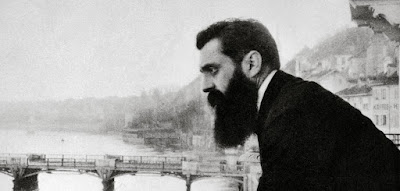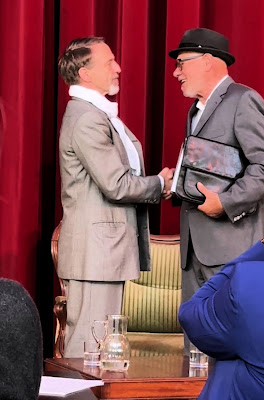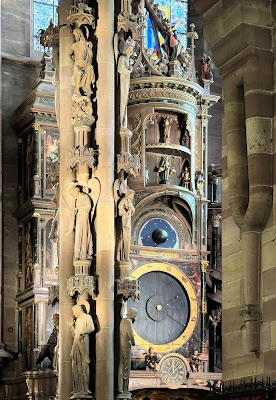Before the Meckels took the floor, an artist donated a painting to the New Synagogue. She painted the Menora during last year's Hanukkah festivities at the Square of the Old Synagogue. Note the model of the former building in the lower right corner.
Marlis is well-known in Freiburg because of her efforts placing stumbling stones (Stolpersteine) in front of houses where Jews and other people deported by the Nazis once lived. They are heaped in the Wiehre because there was a large number of Jewish small businesses like a textile shop, a milliner's store, wine shops, a white linen store, and eight livestock dealers, a traditional Jewish trade. And Jewish university professors, dentists, and lawyers lived with their families in an amiable coexistence with Christians in the Wiehre.
Andreas initiated memorial plates in Freiburg and, in particular, the one on Annaplatz in the Wiehre. Here, on October 22, 1940, Jews were forcibly rounded up and deported into the concentration camp Gurs.
He described Jewish life in Freiburg that started as early as 1230 and was extinguished in the pogrom on January 30, 1349. This was followed on July 4, 1401, by the expulsion of the few Jews who had resettled in the city. King Sigismund confirmed the eternal expulsion of all Jews in 1424.
Eternity lasted 438 years until 1862 when, on April 25, the deputies of the Second Chamber of the Grand Duchy of Baden passed the "Law on the Civil Equality of the Israelites."
I will not report further on Andreas' presentation, for I blogged about the Jewish history in Freibung before 1424 here and about the past from 1862 on here, including the deprivation of rights, expulsion, and murder of Freiburg's Jews in the 3rd Reich.
But what happened during the 438 years when Jews were not allowed to settle within the city boundaries? Here, Andreas had some interesting facts. Jews were allowed to do business in Freiburg from dawn to dusk. They entered through one of the southern gates and, while in town, were accompanied by a city servant during the day. These Jewish merchants had their lodgings in the Wiehre.
Following Andreas' historical account, Marlis spoke and read about the moving fates of Jewish fellow citizens in the Wiehre under the Nazi regime. Meticulously, she works to clarify the history of the people behind each individual Stolperstein.
However, it seems that Fleischmann's doctoral thesis, "The agricultural crisis of 1845-1855 with special reference to Baden," has a particular relevance since it has been reprinted in the States.























































